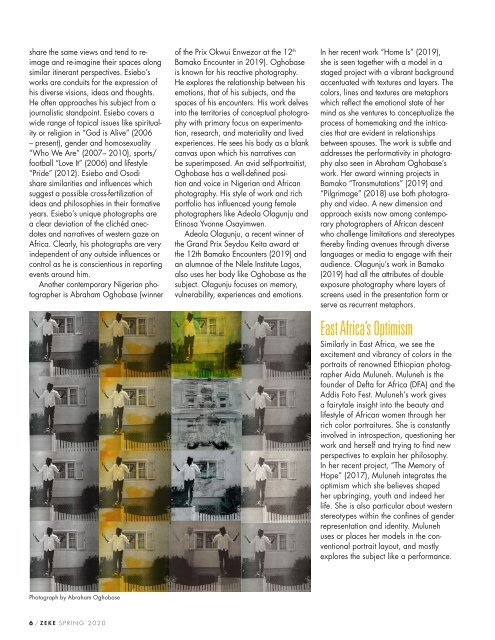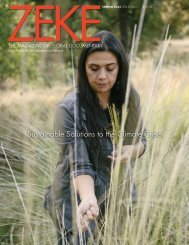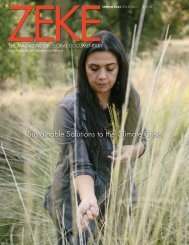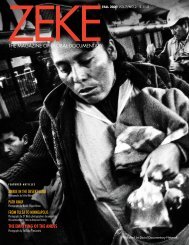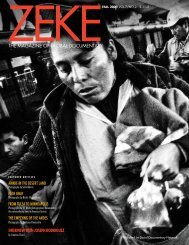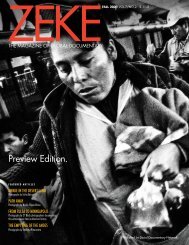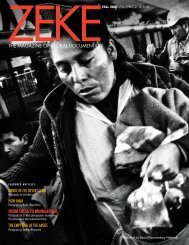Africa's Visual Vernacular by Uche Okpa-Iroha
From Spring 2020 special Africa issue of ZEKE magazine
From Spring 2020 special Africa issue of ZEKE magazine
You also want an ePaper? Increase the reach of your titles
YUMPU automatically turns print PDFs into web optimized ePapers that Google loves.
share the same views and tend to reimage<br />
and re-imagine their spaces along<br />
similar itinerant perspectives. Esiebo’s<br />
works are conduits for the expression of<br />
his diverse visions, ideas and thoughts.<br />
He often approaches his subject from a<br />
journalistic standpoint. Esiebo covers a<br />
wide range of topical issues like spirituality<br />
or religion in “God is Alive” (2006<br />
– present), gender and homosexuality<br />
“Who We Are” (2007– 2010), sports/<br />
football “Love It” (2006) and lifestyle<br />
“Pride” (2012). Esiebo and Osodi<br />
share similarities and influences which<br />
suggest a possible cross-fertilization of<br />
ideas and philosophies in their formative<br />
years. Esiebo’s unique photographs are<br />
a clear deviation of the clichéd anecdotes<br />
and narratives of western gaze on<br />
Africa. Clearly, his photographs are very<br />
independent of any outside influences or<br />
control as he is conscientious in reporting<br />
events around him.<br />
Another contemporary Nigerian photographer<br />
is Abraham Oghobase (winner<br />
of the Prix Okwui Enwezor at the 12 th<br />
Bamako Encounter in 2019). Oghobase<br />
is known for his reactive photography.<br />
He explores the relationship between his<br />
emotions, that of his subjects, and the<br />
spaces of his encounters. His work delves<br />
into the territories of conceptual photography<br />
with primary focus on experimentation,<br />
research, and materiality and lived<br />
experiences. He sees his body as a blank<br />
canvas upon which his narratives can<br />
be superimposed. An avid self-portraitist,<br />
Oghobase has a well-defined position<br />
and voice in Nigerian and African<br />
photography. His style of work and rich<br />
portfolio has influenced young female<br />
photographers like Adeola Olagunju and<br />
Etinosa Yvonne Osayimwen.<br />
Adeola Olagunju, a recent winner of<br />
the Grand Prix Seydou Keita award at<br />
the 12th Bamako Encounters (2019) and<br />
an alumnae of the Nlele Institute Lagos,<br />
also uses her body like Oghobase as the<br />
subject. Olagunju focuses on memory,<br />
vulnerability, experiences and emotions.<br />
In her recent work “Home Is” (2019),<br />
she is seen together with a model in a<br />
staged project with a vibrant background<br />
accentuated with textures and layers. The<br />
colors, lines and textures are metaphors<br />
which reflect the emotional state of her<br />
mind as she ventures to conceptualize the<br />
process of homemaking and the intricacies<br />
that are evident in relationships<br />
between spouses. The work is subtle and<br />
addresses the performativity in photography<br />
also seen in Abraham Oghobase’s<br />
work. Her award winning projects in<br />
Bamako “Transmutations” (2019) and<br />
“Pilgrimage” (2018) use both photography<br />
and video. A new dimension and<br />
approach exists now among contemporary<br />
photographers of African descent<br />
who challenge limitations and stereotypes<br />
there<strong>by</strong> finding avenues through diverse<br />
languages or media to engage with their<br />
audience. Olagunju’s work in Bamako<br />
(2019) had all the attributes of double<br />
exposure photography where layers of<br />
screens used in the presentation form or<br />
serve as recurrent metaphors.<br />
East Africa’s Optimism<br />
Similarly in East Africa, we see the<br />
excitement and vibrancy of colors in the<br />
portraits of renowned Ethiopian photographer<br />
Aida Muluneh. Muluneh is the<br />
founder of Defta for Africa (DFA) and the<br />
Addis Foto Fest. Muluneh’s work gives<br />
a fairytale insight into the beauty and<br />
lifestyle of African women through her<br />
rich color portraitures. She is constantly<br />
involved in introspection, questioning her<br />
work and herself and trying to find new<br />
perspectives to explain her philosophy.<br />
In her recent project, “The Memory of<br />
Hope” (2017), Muluneh integrates the<br />
optimism which she believes shaped<br />
her upbringing, youth and indeed her<br />
life. She is also particular about western<br />
stereotypes within the confines of gender<br />
representation and identity. Muluneh<br />
uses or places her models in the conventional<br />
portrait layout, and mostly<br />
explores the subject like a performance.<br />
Photograph <strong>by</strong> Abraham Oghobase<br />
6 / ZEKE SPRING 2020


